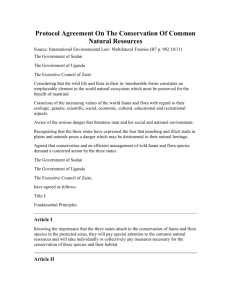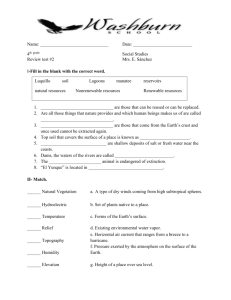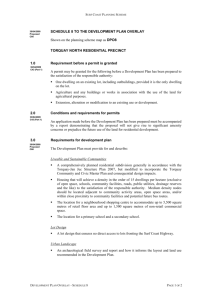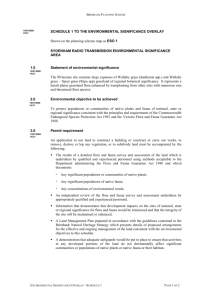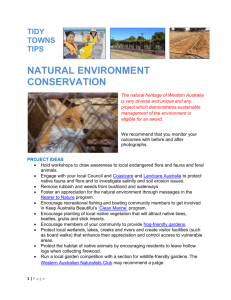Word file
advertisement
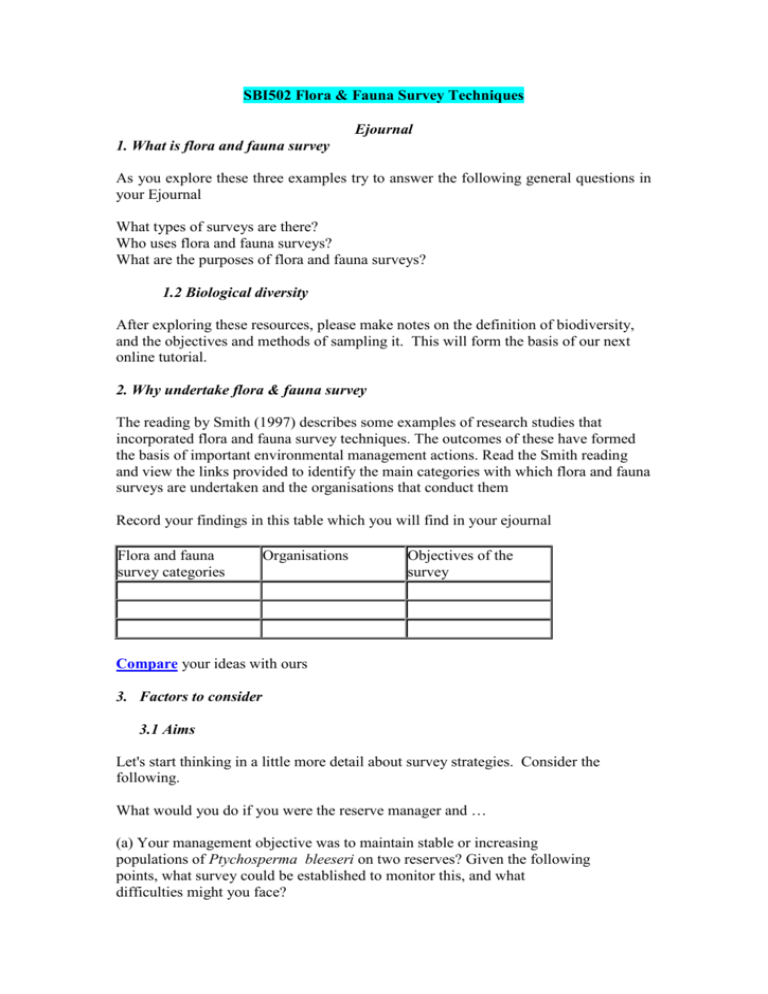
SBI502 Flora & Fauna Survey Techniques Ejournal 1. What is flora and fauna survey As you explore these three examples try to answer the following general questions in your Ejournal What types of surveys are there? Who uses flora and fauna surveys? What are the purposes of flora and fauna surveys? 1.2 Biological diversity After exploring these resources, please make notes on the definition of biodiversity, and the objectives and methods of sampling it. This will form the basis of our next online tutorial. 2. Why undertake flora & fauna survey The reading by Smith (1997) describes some examples of research studies that incorporated flora and fauna survey techniques. The outcomes of these have formed the basis of important environmental management actions. Read the Smith reading and view the links provided to identify the main categories with which flora and fauna surveys are undertaken and the organisations that conduct them Record your findings in this table which you will find in your ejournal Flora and fauna survey categories Organisations Objectives of the survey Compare your ideas with ours 3. Factors to consider 3.1 Aims Let's start thinking in a little more detail about survey strategies. Consider the following. What would you do if you were the reserve manager and … (a) Your management objective was to maintain stable or increasing populations of Ptychosperma bleeseri on two reserves? Given the following points, what survey could be established to monitor this, and what difficulties might you face? Ptychosperma bleeseri is a small shrub that grows in patches the combined populations on both reserves are very small, and confined to small areas (b) Your management objective was to maintain stable or increasing cover (% cover) of Wild rice in three populations on two reserves. populations are distinct, but large and cover large areas (c) Your management objective was to estimate tree density in a savanna before and after a fire? the terrain is rugged management area is large personnel are limited Please send your responses to your lecturer, who will give you feed-back and see if we are all on the same track. Your responses and the feed-back you will receive will then form the basis of our next online discussion. 4. Preparing to sample 4.1 source background information Please consider the following hypothetical, but potentially real, scenario. Please go outside into your garden while you do so (yes we mean it!) You are going to participate it the Birds Australia (formally the RAOU) Bird Atlas project by surveying your home garden for birds. (i) (ii) (iii) (iv) What are you survey objectives and what data do you require What method will you use to survey the avifauna in your garden (you may want to jump ahead to the survey methods section and look at bird survey techniques)? Describe your sampling strategy. If you also wanted to determine what factors attracted birds to your garden, what additional data would you collect? Let's presume you are coordinating 'birdos' in your suburb of district who are participating in the exercise. Design a survey data sheet to be used by everyone. You will be required to send your thoughts to your lecturer so that you can receive feed-back about whether or not you are on the right track. Your thoughts and the feed-back you receive will form the basis of you next online tutorial session 4.2 preliminary site survey Stratification is an important concept to grasp. Let's consider this some more. Please look at the image provided (File: cz landscape). What habitat strata can you identify? How would you stratify your sampling strategy in this terrain if you were sampling (a) vegetation (b) invertebrates (c) reptiles? Please email your replies to your lecturer. These question and the feed back you receive n your replies will form the basis of our next online discussion. 4.5 permits and ethics approval Please download an aminal ehtics research application form from the NTU website. Fill it out for the field work at Charles Darwin National Park. We will discuss this process during our next online discussion. 5. Flora survey techniques 5.1 Vegetation descriptions Refer to Case Study 2 (make a link here) and your previous Ejournal entries on vegetation/flora measurement. Is there anything you want to add to those notes in this topic? Do you have any preliminary thoughts on the methodologies you might use in Case Study 2? We will discuss these issues in our next online discussion. 5.2 Sampling concepts (i) Please describe why and when a gradsect would be used. Give an example of the application of this method, either from your reading or previous work experience. What are the limitations of this method? We will consider this on ournext online discussion (ii) Please describe when and why a plotless (or distance) method of sampling would be used . Describe an example of the use of this method, either form you reading or previous work experience. What are the limitations of this method? We will consider this on out next online discussion (iii) Please read this case study and identify the sampling methodology used. We will consider this on out next online discussion 6. Analysing data 6.2 Types of statistical analysis As you read through the different types complete the following comparison table in your ejournal type uses any strengths or limitations? 7. Presenting data Record your ideas to the following questions in your ejournal: What is the basic structure of a scientific report? What other features need to be included? What attributes does a good report have? (Can you remember one you have read?)


